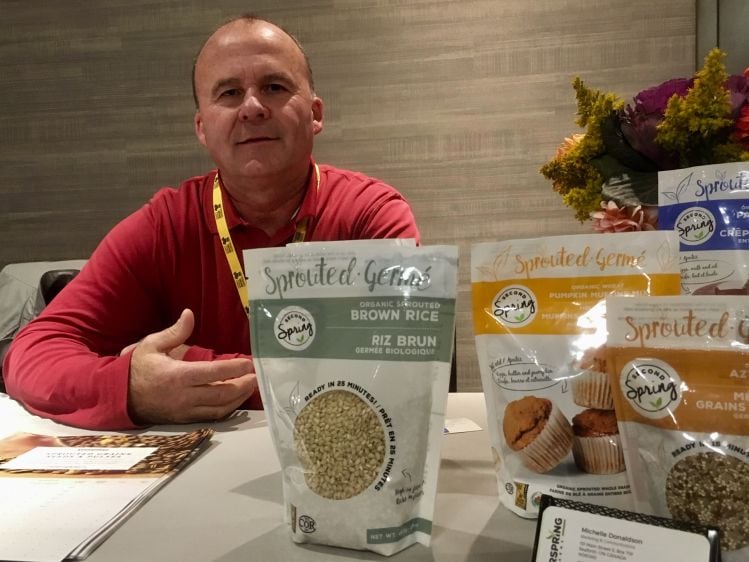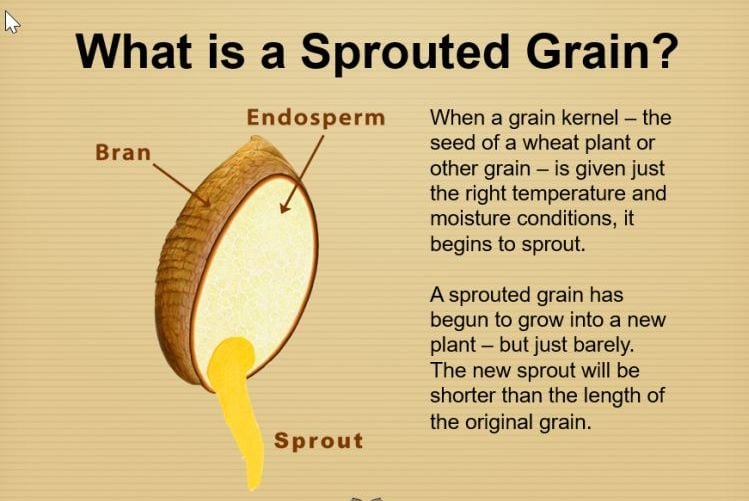Sprouted grains have been allowed to germinate (sprout) in a controlled manner by exposing them to moisture and warmth. This process is then typically halted by drying the grains at just the right time (after beneficial enzymes have been activated to work their magic, but before the grains are ‘drowned’), although some firms mash wet, sprouted grains into a purée that is sold frozen.
While sprouted grains can offer functional benefits for bakers (improved baking performance, better volume and stability, and reduced proofing time), they also promise consumer benefits from improved digestibility to higher nutrient levels and improved flavor.
Tests also show that the bio-availability of some nutrients is also higher in sprouted grains because the sprouting process activates enzymes that eliminate or reduce components such as phytic acid which are designed to lock in nutrients and stop the seed germinating before it’s planted.
However, while the AACCI’s definition (see box below) is often cited by industry, there is no regulated definition of ‘sprouted grains’ and no agreed protocols over when the germination process should be halted**, or what label claims (which nutrients are increased, by how much?) firms can make, Kelly Toups, director of nutrition at Oldways, told delegates at the Whole Grains Council conference in Seattle last week.
Defining standards for sprouted grains is still a work in progress
To explore what a definition might look like, the Oldways Whole Grain Council set up a working group in 2015 working with 47 individuals from 28 companies, and had made a lot of progress, said Toups: “Defining standards for sprouted grains is still a work in progress… what we’ve found is that our conversations lead to more questions than answers.”
One working group member estimated that about 60% of grains on the market are capable of germination (as some are too old, some have been bred to resist sprouting the in the field (which makes them resist intentional sprouting too), and some are rendered unviable by aggressive grain driers or heat treatment to stabilize unsaturated fats in grains such as oats, for example).
Another key factor for sprouted grains is that they must be sprouted intentionally through a controlled process, as those that have accidentally field sprouted should not be part of the food supply, said Toups. “We don’t want to make anyone sick, and this needs to be done in a controlled environment.”
Once you’ve identified viable grains for sprouting, an additional challenge is that nutritional changes vary between grains, and are elusive and hard to measure, she said. To complicate matters further, some nutritional changes peak earlier than others, making it hard to pinpoint a moment of ‘optimal overall nutrition.’
Why sprout grains? According to the Whole Grains Council (click HERE), sprouting grains can cause many changes including:
- Complex molecules become simpler and easier to digest
- Minerals such as iron, calcium, manganese, become more bioaccessible
- Vitamin C, folate, and antioxidants can increase [ORAC scores of sprouted seeds are higher]
- Insoluble fiber decreases; soluble fiber increases
- Gluten decreases
AACCI definition: In early 2008, AACCI’s Board of Directors decreed that, “Malted or sprouted grains containing all of the original bran, germ, and endosperm shall be considered whole grains as long as sprout growth does not exceed kernel length and nutrient values have not diminished. These grains should be labeled as malted or sprouted whole grain.”
Is looking for a visible sprout the best way to determine sprouting?
But nutritional factors aside, why is it so hard to arrive at a workable definition of a sprouted grain? Isn’t the presence of a visible shoot a clear marker of a sprouted grain?
Yes and no, said Toups. “It’s common for some grains to undergo changes consistent with germination without showing a visible sprout … or sometimes it’s hard to see sprouts on tiny grains [such as amaranth]; sprouts can also fall off during drying, and not all grains in a batch sprout visibly. So while a visible sprout confirms sprouting, the lack of one should not disqualify a grain if sprouting can be documented in other ways.”
One useful marker is alpha amylase levels, which increase when grains germinate, with many firms using the FN or ‘falling number test’ (which measures the alpha-amylase enzyme activity in grains) to determine the appropriate point at which to halt the sprouting process. Another method is the RVA or ‘rapid visco analyzer’ test (which indirectly estimates the amount of alpha-amylase by measuring starch viscosity) – but this can be expensive, said Toups.
Amino acids levels, antioxidants
Tests for increased levels of certain amino acids (such as GABA) or antioxidants can also be an indicator of sprouting, or tests to measure a specified percent reduction in phytate. However, as all grains, and even cultivars of the same grains, or different-sized seeds of the same grain, behave differently, it’s going to be very hard to set a ‘sprouted’ standard that applies to all grains, she said.
“Grains in the same batch can sprout at different rates under the same conditions… It’s too soon to say that one approach is best for very company.”
While the AACCI says sprout growth should not exceed kernel length, meanwhile, some seeds grow a long sprout rapidly, said Toups, with some members of the working group cautioning against setting an arbitrary length limit. “At some point however, a sprouted grain crosses the line from a grain to a new plant, and nutritional values diminish.”
Sprouting index?
So what are the next steps? Right now, said Toups, more research is needed into new methods to determine sprouting, with some stakeholders proposing approaches combining protein, starch, and micronutrient tests to create a ‘sprouting index.’
Consumers and sprouted grains
As to what consumers think about sprouting, from a marketing perspective, sprouted whole grains could give the grain industry an opportunity to claw back the initiative in the debate sparked by books like Grain Brain and Wheat Belly by tapping into demand for more nutrient-rich, minimally processed natural foods, said Carlee Kelly, co-founder at product innovation consultancy Lettuce Eat.
“So often processing methods strip nutritional content from our foods, but sprouting is a form of natural processing that can enhance the nutritional attributes of foods. It’s also a traditional method of food prep that’s finding a modern day resurgence as a superfood trend. It’s about awakening the seed from its dormant state.
"What we see when seeds are sprouted are reduced anti-nutrients such as tannins, lectins, phytic acid, and increased bioavailability of micronutrients and increased antioxidants, fiber and protein, and I don't just mean content, but protein quality."
*Source: SPINS natural, speciality gourmet, and MULO (multi-outlet data, powered by IRI) for the 52 weeks to October 7, 2018 (dollar sales).

Dale Donaldson, president of Canadian sprouted grains specialist Everspring Farms, told FoodNavigator-USA that there had been a marked uptick in demand for sprouted grains over the past five years, with consumers buying into the notion that sprouted grains are easier to digest in particular.
"I think consumers have a general sense that sprouted grains are good for you. I think they feel that if the seeds are starting to digest themselves, this makes them easier to digest for humans as well."
From a formulation perspective, whole wheat flour has a shorter shelf-life (as wheat germ contains oil, which can oxidize and cause rancidity) and more astringent flavor than refined wheat flour, said Donaldson. However, sprouting can tackle some of these issues and deliver superior loaf volume, more rapid proof times and dough stability coupled with a sweeter taste, he said.
"Sprouting makes whole grains more user friendly."
One challenge with sprouting is that every grain is different, requiring a different sprouting time, he said. As for claims you can make to consumers, the industry is a "little ways away from making claims" at this stage, he said.


